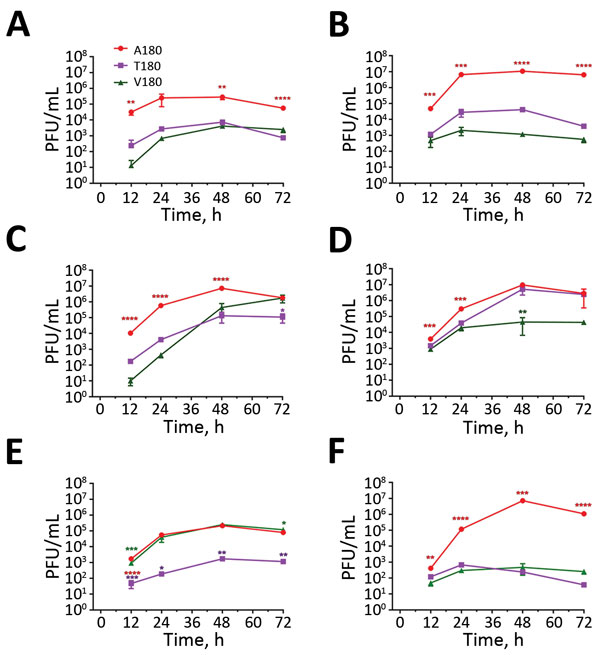Volume 25, Number 1—January 2019
Research
Association of Increased Receptor-Binding Avidity of Influenza A(H9N2) Viruses with Escape from Antibody-Based Immunity and Enhanced Zoonotic Potential
Figure 6

Figure 6. Replication kinetics of influenza A(H9N2) viruses from Pakistan in CKC, MDCK, and MDCK-SIAT1 cells. A, C, E) Replication in CKC, MDCK, and MDCK-SIAT1 cells of UDL-01/08 viruses containing A/T/V180 substitutions; B, D, F) replication in CKC, MDCK, and MDCK-SIAT1 cells of SKP-827/16 viruses containing A/T/V180 substitutions. Virus supernatants were titrated by plaque assay in MDCK cells by using culture supernatants harvested at 12, 24, 48, and 72 hours postinoculation. One-way analysis of variance with multiple comparisons was used to compare virus titers from each time point. A) CKC growth curve: A/chicken/UDL-01/2008 A/T/V/180; B) CKC growth curve: A/chicken/Pakistan/SKP-827/2016 A/T/V/180; C) MDCK growth curve: A/chicken/UDL-01/2008 A/T/V/180; D) MDCK growth curve: A/chicken/Pakistan/SKP-827/2016 A/T/V/180; E) SIAT1 growth curve: A/chicken/Pakistan/UDL-01/2008 A/T/V/180; F) SIAT1 growth curve: A/chicken/Pakistan/ SKP-827/2016 A/T/V/180. *p<0.05; **p<0.01; ***p<0.001; ****p<0.0001).
1Current affiliation: Imperial College London, London, UK.
2Current affiliation: Chinese Academy of Agricultural Sciences, Beijing, China.